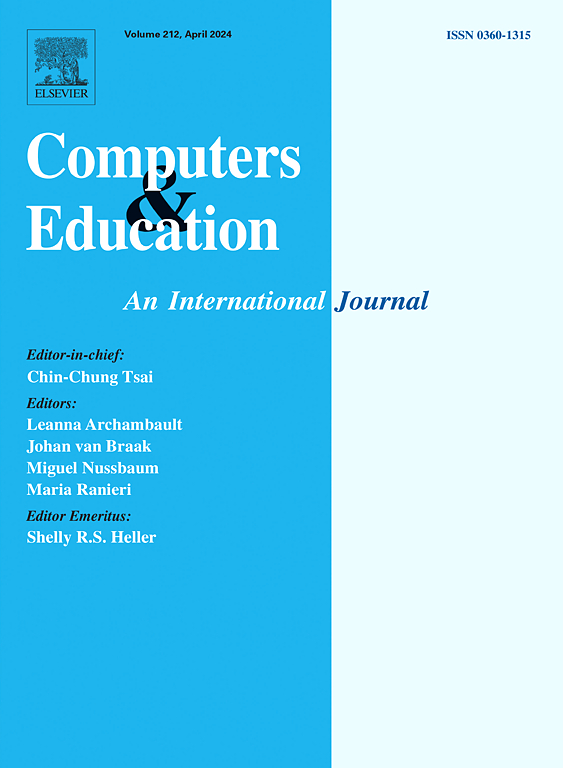在沉浸式视频中聆听科学家:沉浸程度和观点如何影响学习体验
IF 10.5
1区 教育学
Q1 COMPUTER SCIENCE, INTERDISCIPLINARY APPLICATIONS
引用次数: 0
摘要
用头戴式显示器(hmd)观看科学学习视频可以促进在现实世界中可能无法获得的真实体验,从而可能改善科学内容的学习方式以及科学和科学家的感知方式。这些沉浸式学习视频的流行促使人们需要更深刻地理解它们的呈现和设计,以及它们对用户体验和学习的影响。本实验室研究使用HMD(传统2D视频与立体360°视频)和拍摄演示科学家的视角(正面视角与侧面视角)来调查科学学习视频的接受如何受到沉浸水平(LOI)的影响。在观看了360度视频后,参与者(78名大学生)报告了更高的沉浸感、社交和空间存在感、用户参与度、副社交互动、情境兴趣和更积极的认知相关情绪。与横向视角相比,正面视角下的科学家表现出更高的沉浸体验、社会和空间存在感、副社会互动和情境兴趣。此外,当控制参与者的自我概念时,正面视角在学习记忆任务中表现更好。此外,眼球追踪分析表明,当参与者从正面而不是侧面看科学家时,他们对她的关注时间更长。关于科学家的可信赖度,两种情况之间没有发现差异。这些结果表明,360°的沉浸式学习视频和面向讲师的正面视角可以促进科学内容的接受。本文章由计算机程序翻译,如有差异,请以英文原文为准。
Listening to scientists in immersive videos: How levels of immersion and points of view influence learning experiences
Viewing scientific learning videos with head-mounted displays (HMDs) can facilitate authentic experiences that may otherwise be impossible to access in the real world, thereby potentially improving the way science content can be learned and how science and scientists are perceived. The rise in popularity of these immersive learning videos has prompted a need for a more profound comprehension of their presentation and design concerning their impact on user experience and learning. This lab study investigates how the reception of scientific learning videos is influenced by the level of immersion (LOI) using an HMD (conventional 2D video versus stereoscopic 360° video) and the point of view (POV) from which the presenting scientist is filmed (frontal versus lateral view). Participants (N = 78 university students) reported higher immersion, social and spatial presence, user engagement, parasocial interactions, situational interest, and more positive epistemically-related emotions after viewing the 360° videos. A frontal perspective on the presenting scientist led to higher experienced immersion, social and spatial presence, parasocial interactions, and situational interest than a lateral perspective. Additionally, when controlling for participants’ self-concept, a frontal perspective yielded better performances on learning retention tasks. Moreover, the eye-tracking analysis demonstrated that participants fixated longer on the presenting scientist when viewing her from a frontal rather than a lateral perspective. Regarding the perceived trustworthiness of the scientist, no differences were found between the conditions. These results imply that immersive learning videos presented in 360° and with a frontal perspective toward a lecturer can promote the reception of scientific content.
求助全文
通过发布文献求助,成功后即可免费获取论文全文。
去求助
来源期刊

Computers & Education
工程技术-计算机:跨学科应用
CiteScore
27.10
自引率
5.80%
发文量
204
审稿时长
42 days
期刊介绍:
Computers & Education seeks to advance understanding of how digital technology can improve education by publishing high-quality research that expands both theory and practice. The journal welcomes research papers exploring the pedagogical applications of digital technology, with a focus broad enough to appeal to the wider education community.
 求助内容:
求助内容: 应助结果提醒方式:
应助结果提醒方式:


